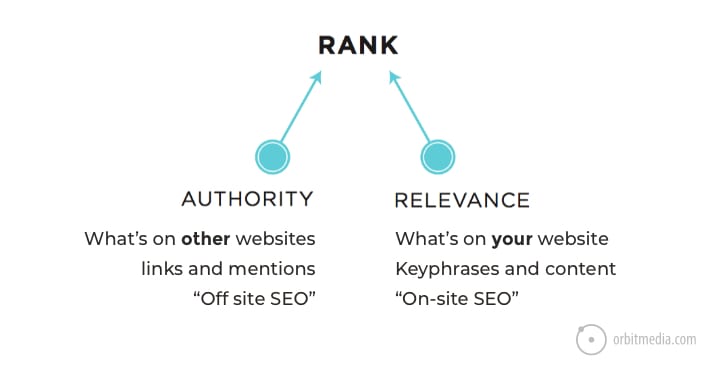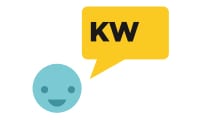Let’s review the basics of SEO (search engine optimization). This is a high-level look at the three main factors involved in search, the art and science of attracting qualified visitors from search engines. It’s a big topic, so we’ll start with a video summary.
You’re about to learn the big concepts: how to do SEO for a website, the tools and techniques, the skills and the job. This article is perfect for you if:
- You’re new to SEO and starting your career as a content strategist.
This will explain all of the basics of search and how to do SEO yourself - You’re an expert SEO and you already know everything about search.
This will help your family understand what you do for a living. Send it to mom.
More likely you’re somewhere in between. Some of this will be review, some of this will feel fresh and new. First, why are we so obsessed with search? Why is SEO so important?

SEO vs. SEM (search engine marketing)
First, there are two kinds of traffic from search engines: paid and organic. Paid search is often called PPC (pay per click) or CPC (cost per click). It’s advertising and it typically appears at the top and bottom of a search results page. Google’s PPC program is called Google Ads.
But SEO is all about the “organic” rankings, which appear in the middle of the search results page. no amount of money can buy these positions here. They aren’t rented, like ads. They are free, or rather, they are earned and won, through search engine optimization.

Search engine marketing (SEM) includes both organic and paid. So you can think of it this way: SEO + PPC = SEM
Beyond paid and organic, there are other types of SEO and specialties and niches within search marketing. Such as local SEO (appearing within maps), technical SEO, international SEO, Amazon, YouTube, Bing and many others. SEO agencies will put in work to improve all of the above.
Let’s start with a quick quiz to review the fundamentals.
Quiz! The basics of search engine optimization
Let’s confirm our understanding of SEO basics with a one question quiz about the factors in search rankings: pages, links and keyphrases.
There is a page on your website. It’s focused on a keyphrase. It links to a page on another website. Finally, there is another page on a third website. It is also focused on a keyphrase. It links to both your site and the second site.

Which of these keyphrases and links affects your search rankings?
A. Keyphrase A (on your website)
B. Keyphrase B (on the other website)
C. Link 1 (the link to your website)
D. Link 2 (the link from your website to another website)
E. Link 3 (the link from the second site to a third site, neither of which are yours)
The answer is A and C.
- Keyphrases on your site affect your search rankings. Keyphrases on other websites do not.
- Links to your website affect your search rankings. Links from your website to other sites do not.
So we’re going to break down SEO into to these two main factors, links and keyphrases. Toward the end, we’ll add a third key factor, “user signals.”
Google famously considers 200+ search ranking factors, but really, there are really just two big ones:

1. Authority: links and credibility
Google is the most popular search engine because of one truly original innovation from its co-founder Larry Page. The late-1990s were dark days for search engines. Search results were terrible. Researchers were experimenting with all kinds of algorithms, trying to figure out how to improve the relevance of search results.
What were the most important factors to consider? Was it the title of the page? Was it the number of times the phrase appeared in the body? The amount of traffic the website seemed to be getting?
Larry’s brilliant insight was to consider a completely separate factor, one that wasn’t on the website at all. His idea was to consider links to the website from other sites. And link popularity (aka “authority”) was born as a search ranking factor.
Suddenly, Google’s search results were so much better than those of Excite, Lycos and AOL, that within a few years, it beat all the other search engines. To this day, links are the most important ranking factor.
It makes sense. A link is like a vote of confidence. If many websites link to a page, that page is probably good. Otherwise, why would those editors, bloggers and journalists have linked to it? Google made the editors of all the websites into the arbiters of quality.
Example: “Jetpacks for kids”
If there are one million pages on the web about “jetpacks for kids,” but one of those pages has been linked to from 100 other websites, that page is probably a credible result for the topic.
And if the links to the kids’ jetpacks page are from sites that are themselves very credible, with many inbound links of their own, then it’s even more likely that the jetpacks page is a good one. It’s getting votes from authoritative sites …and it’s even more likely to rank.
And if the links are from kids sites or sites about space travel, then it’s also more likely that the jetpacks page is a quality source of information because it’s getting votes from relevant sites …and it’s even more likely to rank.
 |
When another website links to one of your pages, it’s a vote of confidence. It’s an indication of relevance, and Google notices. |
 |
When many sites link to one of your web pages, even better. Link popularity works like any popularity contest. You want a lot of votes. |
 |
The best links are from sites that have a high link popularity themselves. These links are worth more. Just like a popularity contest, one vote from someone popular is worth more than a dozen votes from the unknown. |
 |
If a page is linking to several sites, the value of those links is divided. So a link to you from a page that’s also linking to all kinds of other pages isn’t as valuable.
Again, in a popularity contest, if the person who votes for you is voting for three people at once, it’s not as good. You’re really only getting a third of a vote. |
 |
Links from related sites are generally better. A link from a completely irrelevant site is not as valuable since that site doesn’t have as much credibility on that topic. |
 |
“Google is a lot like that really mean girl from high school. Your best shot at getting her to like you is to ignore her while you go about getting social sharing, links, and publicity because you’re trying to reach people. The less you care about what she thinks, the better light she tends to see you in — because real people already like you.” – Sonia Simone, Chief Content Officer, Copyblogger and Rainmaker Digital |
Competition and Keywords
Next, it’s important to understand what is actually ranking here. Google doesn’t rank websites. Websites never rank. Only web pages rank. Relevance is built page by page.
Google is trying to bring the visitor to the best page on the web for the topic. This is why “sprinkling” phrases around a website is a waste of time. But building rich, deep, super useful pages works really well.
Every phrase is a competition. Every page is a competitor.
Tip! Ever wondered why you don’t rank for a phrase? Ask yourself: which page on my site is the most relevant page for that phrase? Then, look carefully at the page and ask yourself: why would Google believe this page to be the best page on the internet for that topic?
So the likelihood of ranking for any phrase depends on the competition for that specific phrase.
If the other high-ranking pages for a phrase are very authoritative (high link popularity) then it’s unlikely you’ll rank unless you are in that same range of authority. This is why famous brands dominate the rankings for many of the most valuable keyphrases.
Keyphrases generally fall on a spectrum of competition, popularity and length.

 |
Do the high-ranking sites for the keyword have higher link popularity than you? Then choose another keyword. |
 |
If your link popularity is low, start with a narrow niche and target longer, more specific keywords. It’s better to rank first for a less popular phrase than rank on page 50 for a big-money keyword. |
Measuring Authority
Back in the day, the authority of websites was measured on a scale of one to ten, as designated by Google. This metric was called PageRank (named after Larry Page) and using the Google Toolbar, you could look it up for any website.
But Google no longer shares that information, so SEO software companies have stepped in and created their own estimates of authority by trying to emulate Google’s own algorithm. These are scores from 1 to 100.
- Moz: Domain Authority
- SEMrush: Domain Score
- Ahrefs: Domain Rating
- Alexa: Competitive Power
- Searchmetrics: Page Strength
They are all essentially the same thing: an estimate of link popularity and likelihood of ranking.
“Off-Site SEO”
There are dozens of ways to win links and mentions from other websites. Some SEO companies focus on “link building” and increasing the authority of their clients’ websites. The best are both very creative and very good at reaching out. Others are simply traditional PR firms that have learned SEO and the value of links.
Here are some of the activities that may have authority benefits:
- Digital PR
- Guest blogging
- Blogger relations / influencer marketing
Learn more with our complete guide on how to increase domain authority.
The job of the SEO is to create high-quality content and then win the attention, the love and the link from a blogger or editor. Content marketing can do wonders for the authority of the website. But that authority is only helpful if you also focus on the second aspect of SEO as well: relevance.
2. Relevance: keyphrases and content
Websites are like people. Some you don’t listen to because they aren’t credible. But other people you don’t hear because they don’t say much. They’re too quiet. So next we’ll look at the ways in which a page can speak up.
Everyone knows you need to use your target phrase on the page. But some people seem to think that there is some formula as if the secret is to use the phrase in just the right place or the right number of times. Meanwhile, they publish pages that no search engine (or human) would ever consider useful or good.
Before you start counting keywords, think about the big picture. Let’s consider what kinds of pages we tend to see at the top of search results.

Ultimately, the goal is to make a great page, but also to indicate that it is relevant. Every time you see or hear the phrase “search engine optimization,” substitute the words “create quality and indicating relevance” and you’ll have the right mindset for good SEO work.
“On-page SEO”
There are lots of places you can use a target keyphrase, but the most visible places are the more important. Here are the four most important places to indicate relevance and some very general guidelines for using your target phrase in your content.

For a more complete look into keyphrase usage, check out Amanda Gant’s SEO Best Practices.
Control + F Test
OK, now let’s count keywords. To check your page, go to the page and press just press control+F. The “find” feature of your browser will search the page for the target keyphrase, showing you where and how many times the phrase was used on the page.

If your page is missing the target keyphrase, you’ve discovered a gap in your content. Log into WordPress and look for sensible ways to include the phrase.
Warning! When counting the instances of a keyphrase, don’t count links or navigation labels. Link text doesn’t indicate the relevance of this page. Link text tells Google that another page is relevant for the phrase: the page the link is linking to!
Keep in mind, the control+F test won’t count the phrase in the title or meta description. That’s code, not content. But they’re still important! Together, they make up the search “snippet” which is the listing on the search results page…

Ultimately, Google isn’t matching words and phrases. It’s matching the intent of the searcher with the true meaning of pages. So the next step in your SEO skills will be to go beyond the phrase into Semantic SEO.
Keyphrase research …Pick your battles
The first step in SEO is always the same: picking your keyphrases. If you do everything else right but get this wrong, you won’t see any results. As a content marketer, you must carefully choose phrases that meet three criteria:
- Search volume: How many people are searching for this phrase?
- Competition: How many websites are relevant for this phrase? Are they powerful sites?
- Relevance: If someone found your site while searching for this phrase, would they be happy? Would you be happy they found you?
The goal is to align the page with a relevant phrase. The ideal keyphrase has high volume, low competition and is highly relevant to your business.
 |
Choose a keyword for which people are really searching and that is relevant to your topic. |
 |
You’re unlikely to rank if you don’t deliberately target a phrase. SEO doesn’t happen by accident! |
 |
You could also hurt your rankings if you overuse the keyword. Keyword stuffing is spam. Indicate relevance, but don’t try too hard. |
You can find our complete guide here: How to Research Keyphrases
3. User Signals …do visitors like your page?
Authority and relevance might determine if you rank. But how your visitors are interacting with the page determine if you’re going to keep ranking. This is the third key factor.
- Is your page getting clicked in search results?
- Do visitors who land on your page stay for a few long minutes or just a few short seconds?
- Do visitors quickly hit the back button and go back to search results to try another page?
Google knows the answers to all of these questions. Each is a different “user interaction signal” and they help Google decide if your page is good or not, if the page is worthy of its ranking.
So we add user signals as a third, major search ranking factor.

 |
“Google is likely using user interaction signals in some form. They look at these signals to ensure that they are getting high engagement from their user base. Why do they care? The reason is simple: higher user engagement helps them preserve market share and maximize their revenue over time.” – Eric Enge |
Visitors who come to your page from a search engine sometimes leave without visiting another page. This kind of one-page visit is called a “bounce.” But there are two kinds of bounces:
- The short click: The visitor hated the page and hit the back button after 3 seconds
- The long click: The visitor loved the page, read every word, stayed for 5 minutes and then finally left
So a “bounce” doesn’t necessarily correlate with high or low quality. But the time on page does.
In my experience, time on page is very important. I’ve seen many high ranking pages with high bounce rates. But if a visitor comes to your page from search and hits the back button after just a few seconds, that could be a big problem for your future rankings.

The difference between these two clicks is the dwell time. Dwell time is the amount of time the visitor spends on your page after arriving from the search engine, and it’s a powerful indicator of quality and relevance.
The key is to create content that makes the visitor want to stay.
That means using visuals that capture attention, formatting the content to help people scan through and finally giving enough depth and detail to draw them deep into the content.
- Short paragraphs
- Subheads, bullets and numbered lists
- Multiple images
- Embedded Video
- Internal links, bolding and italics
- Long, detailed, compelling articles!
How many items from the web content checklist did you include in your article?
Formatting and media affect dwell time. This helps explain the connection between quality and rankings. This is why great pages with high-quality, engaging content tend to rank well. It’s all about the visitor!
“Black hat SEO” and spam
Some search optimizers try to trick Google by using aggressive tactics that go beyond the basic SEO techniques. They stuff pages full of keyphrases. They to hide text behind images. They buy links from private blog networks.
These are all considered “black hat” techniques, as in web spam. If you violate Google’s quality guidelines you risk having your domain blacklisted from Google’s index. Once blacklisted, pages on your domain won’t rank even when people search for the business name.
Anything that you do purely for the sake of Google, with no consideration for human visitors, is spam.
Stick to the ethical, sustainable “white hat” techniques. Create great content (quality), indicate your relevance (keyphrases) to your audience and build genuine connections (links) with related websites.
Google famously has 2,000+ Mathematics PhDs on staff. They’re smarter than me, so I want them on my team. I don’t want a small army of geniuses working against me. So here’s how I think about SEO:
- If you made the best page on the internet for your topic,
there are 2,000 Math PhDs trying to help you. - If you didn’t make the best page on the internet for your topic,
there are 2,000 Math PhDs trying to stop you.
The Bottom Line in Top Rankings
In the end, ranking in search engines is all about quality writing that goes deep and indicates its relevance. It’s posted on an authoritative website, supported with links from other websites. And visitors who find it love it. They stay on the page and engage with the content.
In other words, if you want to rank high, be good. Build and maintain a great online presence. The engineers at Google are trying very hard to help people find you, as long as you make the best page on the internet for your topic. That is the heart and soul of search!




